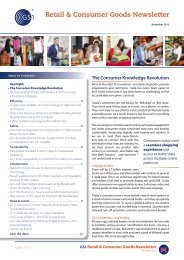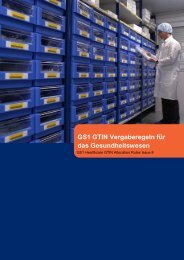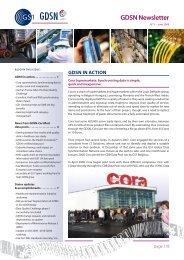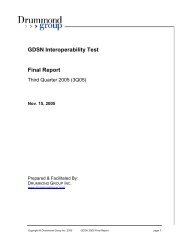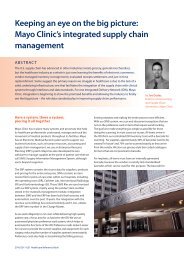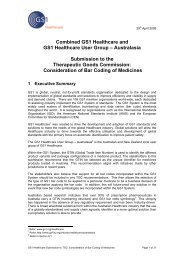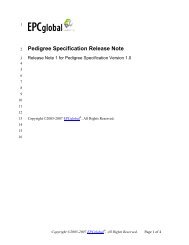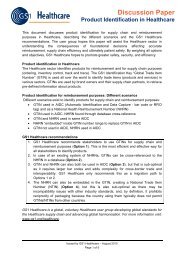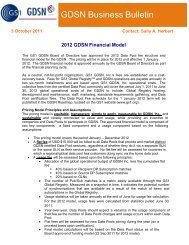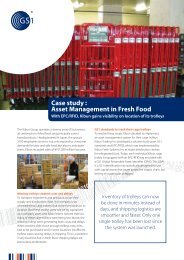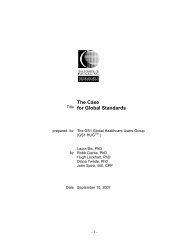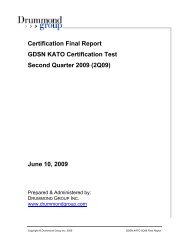Canadian GTIN Allocation Rules for Healthcare - GS1
Canadian GTIN Allocation Rules for Healthcare - GS1
Canadian GTIN Allocation Rules for Healthcare - GS1
You also want an ePaper? Increase the reach of your titles
YUMPU automatically turns print PDFs into web optimized ePapers that Google loves.
<strong>Healthcare</strong> <strong>GTIN</strong> <strong>Allocation</strong> <strong>Rules</strong><br />
The diagram above is a scenario to represent the difficulties in determining when a <strong>GTIN</strong> change is<br />
necessary <strong>for</strong> complex medical devices, depending upon how the device is viewed i.e. from a<br />
Commercial and / or Form, Fit, Function perspective. Nominally the commercial aspects of an FMCG<br />
trade item determine a <strong>GTIN</strong> change, the objective is to recognise that other important factors reside<br />
which may not necessarily signify a commercialization shift, but would impact the <strong>GTIN</strong> assignment <strong>for</strong><br />
<strong>Healthcare</strong>. It is the brand owner’s responsibility to manage appropriately the configuration of any<br />
complex device and its appropriate <strong>GTIN</strong>(s) assignment up to the point of sale. The example shows<br />
major hardware components managed by <strong>GTIN</strong> and Serial Number combinations, recognising that<br />
within this complex medical device there are other potential parameters where configuration change<br />
must be managed; <strong>GTIN</strong> change may be dictated based on the manufacturers change management<br />
process.<br />
Many Medical Devices, particularly high-value electronic equipment, will use the combination of <strong>GTIN</strong><br />
plus Serial Number <strong>for</strong> tracking purposes (rather than the <strong>GTIN</strong>, Batch Number and Expiration Date<br />
which are normally required in other areas of <strong>Healthcare</strong>). It is the Brand Owner that decides upon the<br />
identification requirement.<br />
6.3.2. Minor Software Configuration Change<br />
A minor change in software configuration, which is provided on a non-commercial basis and has no<br />
impact on the function of the device, has no impact on <strong>GTIN</strong> <strong>Allocation</strong>. Examples include bug fixes,<br />
language options (provided <strong>for</strong> free), minor version updates, etc.<br />
6.3.3. Major Software Configuration Change<br />
A major change in software configuration that adds to, or changes, the functionality requires the two<br />
configurations to be distinguishable through the allocation of different <strong>GTIN</strong>s. Such changes would<br />
normally be provided on a commercial basis and trading partners need to distinguish the two<br />
configurations <strong>for</strong> pricing or ordering or invoicing. Additional examples include software updates that<br />
provide additional product features, or signification version updates.<br />
Figure 6-9 Major Software Configuration Change – New <strong>GTIN</strong><br />
6.3.4. Inclusion of a Certification Mark<br />
Within the <strong>Healthcare</strong> sector there are many examples of certification marks. A certification mark is a<br />
symbol, logo or wording on a product that declares con<strong>for</strong>mance to a regulated set of criteria (e.g.,<br />
European Certification Mark CE). When a product is changed to include a certification mark (which<br />
was not previously shown on the packaging or product itself) a new <strong>GTIN</strong> should be allocated <strong>for</strong><br />
markets where the certification mark is of particular relevance. It is a key principle of <strong>GTIN</strong> <strong>Allocation</strong><br />
that the <strong>GTIN</strong> identifies uniquely the product and its packaging configuration.<br />
03 October 2007, Final All contents copyright © <strong>GS1</strong> 2007 Page 21 of 26



